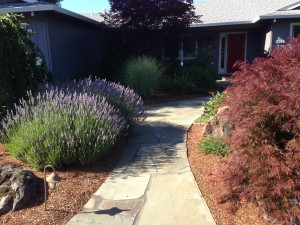Details Landscape Art designs and builds all different style gardens in Petaluma, Santa Rosa, Healdsburg, Windsor, Sebastopol, Penngrove, Cotati, Kenwood, Sonoma, Novato, San Rafael, Napa, Mill Valley, Corte Madera and Larkspur. We have many plants that we use on a regular basis, and one of our favorites is lavender. 
The color fragrance and texture are unbeatable. The soft feel and the bluish purple color blend and contrast with white roses, maroon barberry, golden breath of heaven, rich green euonymus, evergreen lomandra grasses, and a host of other full sun plantings. Lavender is also often used for it’s fragrance in perfumes, aromatic oils, sachets, soaps and lotions. And most forms of this aromatic perennial attracts bees and hummingbirds! There are many lavender farms throughout Northern California where fields of lavender are grown. We noted fields in Provence, France that stretch to the horizon! And since we feel that fragrance is another delightful element in the garden, masses of lavender smell wonderful.The texture of lavender is unique, and adds a nice soft texture contrast with the structured branching of Japanese maples, with the chunkier look of some basic dark green shrubs, with upright grasses, and with solid blocks of color like roses.
Perennials require deadheading, and lavender must be cut back several times a year. Depending on variety and location, it may bloom in April for a few weeks. When the blooms are mostly spent, if the plant is cut back, a second flush of blooms will appear in June. The process is repeated after the second bloom is spent and a third flush may bloom in August. Another pruning may yield still a fourth bloom in late September! If this deadheading is NOT done after each bloom cycle, the plant will get leggy and woody. So a potentially long cycle of beauty can easily become an unsightly mess if the plant is not properly maintained. So make sure you are willing to put in the time if you want to enjoy the lovely flowers and texture of this beautiful perennial. They need well drained soil and little or no fertilizer.
They are relatively drought tolerant, thrive in dry rocky soil situations, and need little water once they are established. The other maintenance issue to note is that these perennials are not long lived. Although hardy and semi-evergreen, they bloom themselves to death after three or four years (in spite of deadheading), and must be replaced.
There are several varieties that we regularly use:
- Lavandula ‘Provence’ (French lavender) – our favorite grows to about 3-4 feet (including soft periwinkle colored flowers). ‘Alba’ has spikes of white blossoms from early summer through fall.

- Lavandula ‘Stoechas Quastii’ (Spanish lavender) – a chunkier, darker purple flower
- Lavandula Angustifolia ‘Hidcote’ (English lavender) – purplish blue flowers on a smaller plant 18” – 24” tall and wide.

- Lavandula Angustifoliua ‘Munstead’ – one and one half feet tall, two feet wide. Bright lavender flowers on green foliage.
Bluish purple is an important color to add to a garden. If the homeowner doesn’t mind occasional deadheading, lavender will do the trick!

